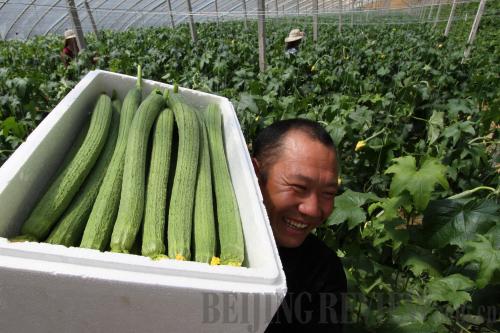|
 |
|
FAMILY FARM THRIVES: Zhao Zunfeng, a farmer in Weifang, east China's Shandong Province, carries loofah on the family farm he set up on April 9. Zhao made considerable profits by selling his produce to high-end markets, including hotels and supermarkets (DU YUBAO) |
Wind Power Boom
China's wind power sector saw a boom in 2012 and state-owned enterprises (SOEs) controlled a sweeping majority of investment and construction in the sector, accounting for about 81 percent of the sector's installed capacity, the National Energy Administration (NEA) said.
As of the end of 2012, some 1,300 companies had invested in or built wind power development projects, of which 1,000 were controlled by SOEs, according to NEA data.
The China Guodian Corp. is the most aggressive in developing wind power, with an aggregate of 13 million kw of on-grid installed generative capacity, followed by China Huaneng Group and China Datang Corp., which had 8.34 million kw and 7.71 million kw of capacity, respectively.
A total of 1,445 wind power farms had been built by the end of last year, while 62.66 million kw of installed capacity had been connected to the state grid by the end of 2012.
China's wind power generation jumped 41 percent from a year earlier to reach 100.8 billion kw-hours in 2012, accounting for about 2 percent of the total amount of electricity sent through the national power grid, according to NEA data.
Down Payment Raised
Beijing raised the minimum down payment for second homes in the city to 70 percent from the original 60 percent starting from April 8.
The policy applies to both commercial and housing accumulation fund loans, in a bid to rein in the overheated property market.
It follows a series of property curbs in the capital, including the introduction of a 20-percent capital-gain tax from sales of previously owned homes.
Buyers without property ownership records in the municipal property transaction information system are eligible for the down-payment ratio of 60 percent, even if they are found to have records of borrowing a home loan or withdrawing money from the housing accumulation fund, according to an announcement issued by the municipal housing accumulation fund center on April 7.
Mortgage rates will remain at 1.1 times the benchmark one-year lending interest rate. | 